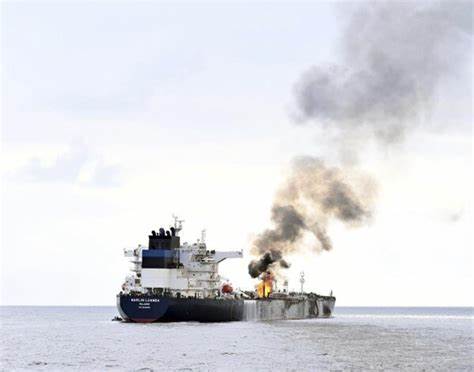(Photo courtesy of AP news). “Houthi attacked oil tanker in the Red Sea.”
Michael Makiej
Connector Staff
In the roughly one-hundred days since the start of the Israel-Palestine war, the regions affected have grown far beyond the one-hundred-forty square miles of the Gaza strip. One of the many consequences of this growing conflict has been the response from the several other Middle Eastern countries in the region. These nations, many of which are sympathetic to the Palestinians, have taken both direct and indirect military actions to hinder Israel’s efforts.
One of these several pro-Palestine groups are the Houthis, an Iran-backed military organization based in Yemen. Less than two weeks after the initial surprise attack by Hamas in Southern Israel, the Houthis began using missile platforms and drones to attack ships and other targets in the Red Sea.
According to Houthi representatives, their attacks are in direct response to Israel’s blockade of the Gaza strip, and they intend to continue their assault until the blockade is abated and a ceasefire is declared by Israel. While the Houthis allege that their only targets are ships which are supplying or aiding Israel, this has been contested by several Western media outlets. Several vessels whose links to Israel remain unclear make the credibility of the Houthi’s claims more tenuous.
Another detail which further complicates Houthi activity in the Red Sea is its geography. More specifically, the Houthi’s control over the nearby Bab-el-Mandeb strait, a significant point in global trade routes, has made their attacks double as both a constant pressure against Israel and the international supply chain.
This constant pressure has necessitated several responses both by Israel and other Western militaries. American Navy vessels have intercepted several missile and drone strikes originating from Houthi controlled territory for months; however, it appears to have had little effect on dissuading the Houthis. In recent days, these attacks have only become more intense. This past Friday, Jan. 26, the Houthis launched one of their missiles directly at the USS Carney, which was the first time since they began their assaults that they directly targeted a U.S. warship.
According to UMass Lowell Professor of Political Science Jarrod Hayes, the asymmetric advantage the Houthis currently have over the US military is significant. Hayes said, “They sit at a particular geographic point where they can exert a lot of pressure with relatively low technological demands and relatively inexpensively.” This point, the Bab-el-Mandeb strait is far narrower than other similar Middle Eastern straits in the Persian Gulf, further boosting the control of the region that the Houthi’s oversee.
Additionally, the weapons platforms acquired by Yemen, in part from Iranian funds, consist of far cheaper and more plentiful munitions. While the U.S. and U.K. both have more sophisticated artillery, it is also far more expensive for them to operate. Professor Hayes believes that this cost benefit analysis may affect the willingness of these militaries to continue to engage the Houthis, stating that, for them, the question becomes, “How much [do we] want to spend tens of thousands of dollars per salvo?”
Despite the serious advantage the Houthi’s currently hold in the region, Professor Hayes says that such an advantage is fleeting, and thinks people should be wary of overstating their case. “There’s a pretty hard stop on the escalatory ladder with respect to Yemen [and US involvement] … because there’s no scenario that has any positive outcome [for the US and UK].” While Professor Hayes permits the possibility of small escalations, such as an increased presence in Yemeni airspace, he stated that something further, like ground invasion of Yemen, is highly unlikely.
In the wake of this direct attack against the USS Carney, the response by the United States may be telling of future plans in that theater. In the meantime, global trade continues to be rerouted and stalled until a resolution can be reached.




